Summary | Definitions | Squares | Grid Size | Grid Shape, Style | Difficulty |
Clues | Themes | Publishing | Other Word Puzzles | Glossaries

via Wikimedia Commons
Summary
- Crosswords vary widely:
- by shape, size and difficulty
- by grid / style: free-form, themed, themeless, cryptic, rebus, barred,
cipher, diagramless, fill-in, etc. - by language, types of clues, themes
- by constructors, editors, publishers.
(as opposed to everyday "problems")
and has a right answer
(as opposed to a game (no answer)
or a toy (no goal))
Definitions
- puzzle, word puzzle: "a problem or enigma that tests the ingenuity of the solver"
- cruciverbalist: "a person skillful in creating or solving crossword puzzles -- and other word games"
- enigmatology: "the study of all that puzzles" ~Will Shortz his self-designed major at Indiana University, 1974
 crossword: "word puzzle that normally takes the form of a square or rectangular grid
crossword: "word puzzle that normally takes the form of a square or rectangular grid
of answer squares and shaded block squares.- Squares in which answers begin are usually numbered.
- The clues are then referred to by these numbers and a direction."
- Other languages may have a different term for "crossword", for example:
- Afrikaans: blokkiesraaisel, e.g., EasyAfrikaans
- Chinese: 填字游戏 [above right], e.g., LexisRex
- Danish: krydsord, e.g., LexisRex
- Dutch: kruiswoordraadsel, e.g., LexisRex
- French: mots croises (grilles); more info, e.g., LexisRex
-
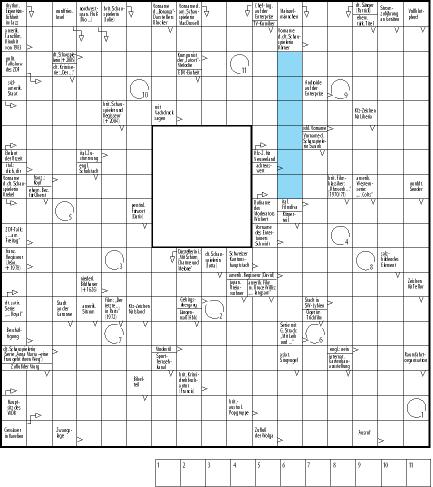
German-style grid by Michael Joachim Lucke
Creative Commons Attribution-Share Alike
3.0 Unported license via Wikimedia CommonsGerman: kreuzwortratsel [right], e.g., LexisRex
- Hebrew: תשבץ; e.g., Kefar;
"In Israel,... - Italian: cruciverba; more info; e.g., LexisRex;
"The Italian language is... - Japanese: クロスワード; image, more info; e.g., LexisRex;
"In Japan,.... - Klingon: crossword
- Latin: crucivocabulorum, e.g., LexisRex
- Norwegian: kryssord, e.g., LexisRex
- Polish: krzyżówka; e.g., LexisRex;
"In Poland,... - Portuguese: palavras cruzadas, e.g., LexisRex
- Russian: кроссворд, e.g., LexisRex;
Vladimir Nabokov coined the term "kreslovitsa" -- literally, "cross" plus "words"
-- but under the secular Bolshevik regime, "krest" flirted too close to religion,
so instead, "krossvords" was used. -

"Crucigrama (crossword)"
by señorita leona is licensed
under CC BY-NC-ND 2.0Spanish: crucigrama [right], e.g., LexisRex
- Swedish: korsord (arroword), e.g., LexisRex;
shaded cells often replaced by boxes with clues (arrows, photos);
"Believed to have originated in Sweden,... - Turkish: bulmaca, e.g., LexisRex
- Ukrainian: кросворд, [image, top right], e.g., Lang-Trans-Help
- "To be able to solve a crossword puzzle in a second language...
- 104+ languages via Google Translate: "crossword"; 63+ via Bing translator incl. Klingon!
- How to Say Crossword in Different Languages
- LexisRex crosswords in many languages
- Crosswords in other languages examples; 5/29/2013
- Wikipedia: crosswords in other languages: orthography, grid design, clues, and conventions;
cryptics in other languages - see also: CROSSWORDS and YOU: Why: Language, Skills, Vocabulary
Squares
- answer squares/cells (or whites, lights)
- checked, crossed or keyed: A answer square that is part of two entries (both Across and Down) -- typical US puzzles;
one that is part of only one entry is called unchecked, uncrossed or unkeyed, e.g., free-form, cryptics - blocks (or darks, blanks, black squares)
- American puzzles have conventions about number/proportion of blocks in themed (~1/6) and themeless puzzles
- grid: the pattern of answer squares &. blocks -- often symmetric
- entries or answers: rows (Across) and columns (Down) of empty squares into which answers are written
Grid Size
- Most English-language puzzles are square by convention -- sometimes rectangular; some typical sizes:
 Mini: 5 x 5, 7 x 7 (Sat); e.g., NYT: A Mini History of Our Mini Crossword
Mini: 5 x 5, 7 x 7 (Sat); e.g., NYT: A Mini History of Our Mini Crossword- Midi: 7 x 7, 9 x 9
- Weekday: usually 15 x 15
- Sunday: 21 x 21, 23 x 23, 25 x 25; Six special "Millennium" puzzles celebrated the 20th Century
- Jumbo: 27 x 27; Bicentennial NYT puzzle
-
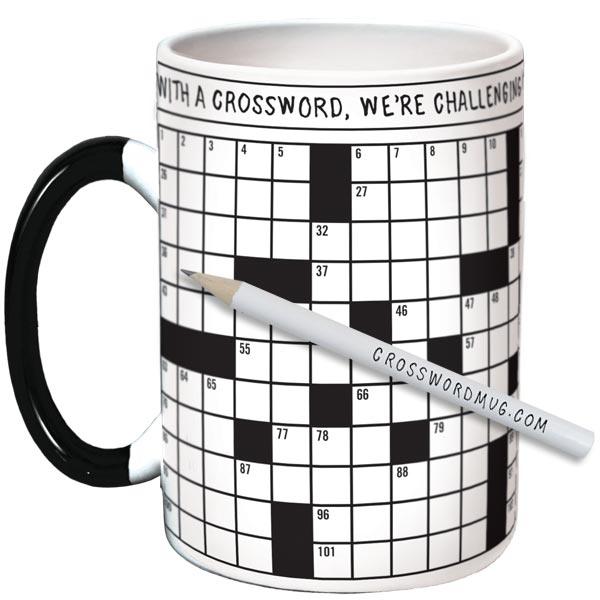
“With a crossword we're challenging ourselves
to create order out of chaos.” ~Will Shortz;
from: crosswordmug.comcrosswordmug.com: 29 x 11;
slogan: "Don't Just Do the Puzzle OVER a Cup of Coffee -- Do It ON Your Cup of Coffee";
.pdf (to avoid writing on/erasing mug...) - 'Holiday': sometimes larger-than-usual puzzles at year-end, e.g., 'mammoth' Christmas
43 x 49; Cleveland Plain Dealer; .pdf; not fully crossed; many 2-letters; 12/25/2020 - Super Mega NYT Puzzle Mania paper insert; or order: store.nytimes.com;
50 x 50 (728 clues): 12/18/2016; 53 x 53: 12/17/2017; 50 x 50: 12/2018, 12/15/2019;
50 x 51: 12/2020; 50 x 50: 12/2021; 67 x 41 (782 clues): 12/2022 - "The 'Super Mega Crossword' was the center of attention for much...
 Puzzle Mania - Dec. 2022 NYT; 12/18/2022
Puzzle Mania - Dec. 2022 NYT; 12/18/2022
This seventh edition of Puzzle Mania, published Sunday, Dec. 18, 2022, is the annual section
of the NYT that entertains long past its cover date. This year you’ll need extra time to solve the
“Super Mega” crossword, by Joel Fagliano, which is larger than ever before, at a whopping
782 entries where the grid alone takes up three newspaper pages.
Accompanying the crossword are seven mini puzzles by composer and quizzicist Greg Pliska.
Together the crossword and mini puzzles are like a treasure hunt or escape room in newspaper form.
Solve everything, then follow the directions to get a 'meta-answer.' Elsewhere in this issue are
seven other variety puzzles and a “Super Seven Search” by Will Shortz on the front page.- for articles & puzzles, see History: 2016-2019, 2020-
- Even larger puzzles -- some world records (Wikipedia)
- Best World's Biggest Crossword 209 x 209; free; 2017
- Ubercross Abecedaria 116,370 clue-answer pairs in its 25 interlinked parts; awaiting Guiness certification .pdf; free
- 1949: 111 x 111; 2,007 clues across, 2,008 down; Robert M. Stilgenbauer;
twenty-seven years later, no one had finished it - 1976: 82,951 squares; 12,489 clues across; 13,125 clues down; Robert Turcot
-

"166/366 Crossword XL" by geinography
is licensed under CC BY-NC-SA 2.01996: 303 x 303; 28,000 clues; from Herbko toy manufacturer,
advertised in the SkyMall catalog on airplanes;
7' x 7'; 100-page clue book; World's Largest Crossword Puzzle - 2007: 132,020 squares; 12,842 clues across;
13,128 clues down; 15 Fascinating Facts About Crosswords: #13 - 2008: 400 x 400; 160,000 squares; 30,711 clues across;
30,690 clues down; 112 m2 - 2008: 320,500 squares;
book of clues for the puzzle is 800,720 words long;
Yemeni man submits puzzle to Guinness:
"Finding ballpoint pen ink wasn't clear enough on
his paper, Qasem filled his pens with a medicine meant for
curing simple burns. Despite this effort, his once 'very good'
eyesight has weakened, forcing him to wear glasses. His back
also hurts from the experience, and any quick movement hurts
him to the extent that he is bedridden for the next two days." - 2009: 19 x 34; 80 clues; 100' tall; Giant Crossword of Lviv (var. Lvov), Ukraine:
"interactive art work aimed at bolstering critical thinking and urban exploration.
Similar to a scavenger hunt, clues are scattered throughout the city’s major landmarks.
Visitors must explore popular attractions, such as historic monuments, museums or parks,
before they’re able to solve the building’s brainteaser. To further tantalize visitors, the
answers are displayed in fluorescent lettering that can only be viewed when lit up at night.
Each nightfall, tourists can be seen crosschecking their results outside the towerblock." - 2012: 160,650 squares; 32,252 clues across; 32,656 clues down;
Guinness record: largest online - 2014: 93,769 clues; 300 m long; current Guinness record: unpublished
- 2016: 244,971 squares; 33,018 clues across; 33,648 clues down;
Nikoli Co., Ltd. (Japan); ~12 m2 (~130 ft2); current Guinness record: published;
"The cost of a limited-edition copy is 250,000 yen (almost $2,000)."
~NYT Puzzle Mania, p. 11; 12/17/2017 - 2020: 103 x 103 (10,069 squares); 1,284 clues;
The Big Crossword app -- world's biggest crossword puzzle
only 'the biggest' published in an app -- not paper? 2/7/2020
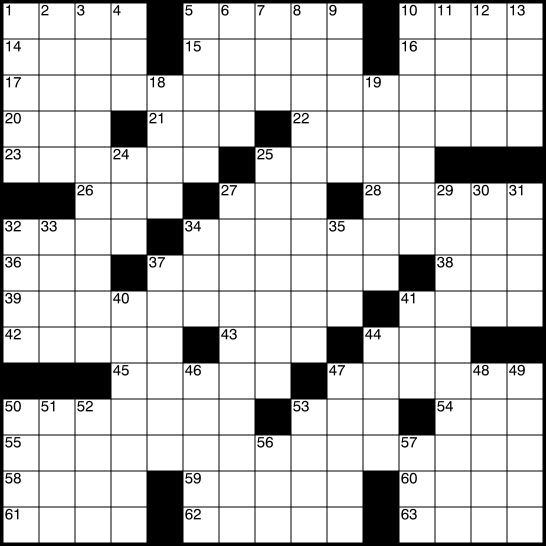
Attribution-Share Alike 3.0 Unported
via Wikimedia Commons
Grid Shape, Style
- shapes: rectangular: foreign; custom, e.g., maps, tree, heart, etc.
- American-style (US) grid: solid areas of answer squares; every letter checked;
rotational symmetry (identical if turned 180-degrees) usually; horizontal/vertical (flipped) sometimes - Wikipedia: New York Times (NYT)
- Why are crossword puzzles symmetric?
-

British-style grid by MeekMark,
public domain
via Wikimedia CommonsBritish-style (UK) grid: lattice-like structure; more shaded and unchecked squares;
symmetry (180-degree rotational) - Wikipedia: Cryptic
- France, Italy: crosswords are smaller than English-language crosswords, and not necessarily square
- they need not be symmetric and two-letter words are allowed
- Italian crosswords are usually oblong and larger than French ones
-

Japanese grid by MeekMark,
Public domain
via Wikimedia CommonsJapan: shaded cells may not share a side; no blocks in corners
- one syllable (typically katakana) rather than one letter is entered into each answer cell
 free-form, vocabulary or criss-cross: simple, non symmetric designs.
free-form, vocabulary or criss-cross: simple, non symmetric designs.- Grids forming shapes other than squares are also occasionally used.
- quadrupuzzle: essentially four small puzzles joined in the center by a few letters.
- Each quadrant needs to be solved separately. example
- Specialty Crosswords: Exploring Unique Variations and the Evolution of an Intellectual Art Form
Cryptic, Diagramless, Acrostic, Rebus, Barred, 3-D; TheWeek; 9/9/2023 - circular: answers entered either radially or in concentric circles
- two-for-one crossword: 2 grids, 1 set of clues (NYT Variety)
- petal puzzle: 'Clockwise, Counterclockwise'
"Enter each clue’s answer in the diagram in a curve,
starting with the correspondingly numbered space
and ending near the flower’s center. Each numbered
space begins two answers, one to be entered clockwise,
and the other counterclockwise."; example - spiral puzzle: 'Inward', 'Outward'
"Spiral puzzles consist of a grid of letters that corkscrews toward the center.
Every space in the grid is used exactly twice, once in each direction."; example - Follow The Yellow Brick Road
- Will Shortz Explains How a Spiral Puzzle Comes Around 12/16/2017
- marching bands: 'Rows', 'Bands'
"The words in this puzzle march around the grid in two ways. In one formation ('Rows'),
words march 3 across -- two words for each numbered line, reading consecutively
from left to right. The dividing point between these answers is for you to determine,
except in Row 7, where the words are separated by a block. In the second formation
('Bands'), words march around each of the six shaded and unshaded bands starting
at the lettered squares (A, B, C, D, E and F) and proceeding in a clockwise 5 direction,
one word after another. For example, Band A will consist of seven consecutive answers
(a through g) starting in Square A and reading around the perimeter of the grid.
Again, the dividing point 6 between these answers is for you to determine.
All clues are given in order. When the puzzle is completed, each square in the grid
will have been used once in a Row word and once in a Band word."; example - split decisions: figure out pairs of words that share letter strings; examples: NYT, Piscop
- In addition to Spiral, Marching Baands and Split Decisions,
NYT Variety ($) features many crossword-like word puzzles,
esp. in the weekly "Little Variety", e.g., Two-for-One Crossword:
each clue has two answers. One goes in the grid on the left, the other
in the grid on the right. Whirlpool, Snake Charmer, Double or Nothing,
For Starters, Crazy Eights, etc. -
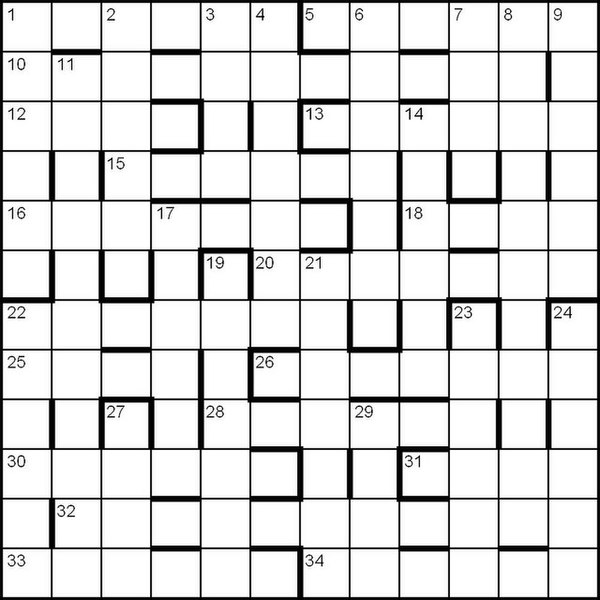
Barred Grid Crossword
by Ross Beresford
Creative Commons Attribution
2.0 Generic license
via Wikimedia Commonsbarred crosswords: bold lines between squares separate answers
(instead of shaded squares) - Azed: barred cryptic
- diagramless, skeleton: "the grid offers overall dimensions, but
the locations of most of the clue numbers and shaded squares are unspecified. - A solver must deduce not only the answers to individual clues,
but how to fit together partially built-up clumps of answers
into larger clumps with properly-set shaded squares." examples  cipher crosswords, codewords:
cipher crosswords, codewords:
"clues for each answer cell of the grid - an integer from 1 to 26 inclusive is printed
in the corner of each. The objective, as any other crossword, is to determine
the proper letter for each cell; in a cipher crossword, the 26 numbers serve
as a cipher for those letters: cells that share matching numbers are filled
with matching letters, and no two numbers stand for the same letter.
All resultant entries must be valid words. Usually, at least one number's letter
is given at the outset. English-language cipher crosswords are nearly
always pangrammatic." examples fill-in, wordfill, crusadex:
fill-in, wordfill, crusadex:
"a grid and the full list of words to be entered in that grid, but does not give explicit clues for
where each word goes. The challenge is figuring out how to integrate the list of words together
within the grid so that all intersections of words are valid."
Difficulty
- larger puzzles are not necessarily more difficult, but can intimidate and take longer
- commuter crossword: usually "quick and easy" clues Mon-Fri; often comparable to NYT Mon
 increasing difficulty, e.g., NYT, LAT:
increasing difficulty, e.g., NYT, LAT:- Mon, Tue: 'easiest'
- Wed: 'medium difficulty'
- Thu: 'more difficult'
- Fri, Sat: 'most difficult' -- usually themeless
- Sun: like 'hard Wed' or 'easy Thu' but larger (21 x 21); NYT
- Discussion of crossword (Wed, NYT 9/7/2022), whose entries described a new solver tackling Mon-Fri crosswords
- Seven (Mon-Sun) songs inspired by NYT Crossword puzzle difficulty (songs; .mp3) by John Schnall;
MayasMix @ Mo: 79:49; Tu: 79:54; We: 80:13; Th: 80:52; Fr: 81:54; Sa: 82:47; Su: 83:38 - Decreasing difficulty, e.g., New Yorker: Fri (easiest) - Mon (hardest):
- American Crossword Puzzle Tournament: oldest/largest US crossword puzzle tournament;
official ACPT site; 2005 tournament featured in 2006 movie WordPlay - Why: Financial: Other Tournaments
Clues
- FITB: Fill In The ___
- gimme: an answer that any player will get easily, e.g., 'Lincoln's nickname' in three letters
- crosswordese: "words frequently found in crossword puzzles but seldom found in everyday conversation"
- e.g., SERE, OLIO, OMOO, ULEE, ETUI, ANOA, YSER, ERN, ERNE, NENE; fewer in 'better' puzzles;
more lists under Solving: Vocabulary - straight or quick: usually 'simple' definitions (like most US puzzles, in contrast to cryptic clues in UK-style)
- to be described more later: Solving Strategies:Choose Appropriate Difficulty
- double-clue lists: choose between straight or cryptic clues
-

British-style grid by MeekMark,
public domain
via Wikimedia Commonscryptic: typically, a cryptic grid isn't 'fully crossed'; a cryptic clue has two parts:
straight definition; other part may signal an anagram, pun, reversal, etc.
common in Great Britain and Commonwealth countries. - "clues are puzzles in themselves. A typical clue contains both a definition at the beginning
or end of the clue and wordplay, which provides a way to manufacture the word indicated
by the definition, and which may not parse logically. Cryptics usually give the length of
their answers in parentheses after the clue, which is especially useful with multi-word
answers. Certain signs indicate different forms of wordplay." - two other differences: cryptics are often themeless; constructors ('setters') often use pseudonyms
- NYT Puns & Anagrams are an easier form: fully crossed grid, with only a few cryptic clue types
Themes
- themed: several entries share some relationship, type of pun, or other element in common,
e.g., category, quotation, rebus, commemorative event; hints to theme are often found in puzzle title,
and in marked clues (e.g., *, ?, CAPS) or special clues (e.g., 'the theme is'; 'marked clues share');
see Solving: Discover the Theme - Theme entries are typically the longest entries in American puzzles,
and are most commonly found in symmetric Across rows, but sometimes in Down columns. - The theme is "explained" by a title (if present)
and/or a "reveal" -- typically the bottom or center entry. - There are conventions about the number of theme entries and theme letters in different size puzzles.
- rebus: type of puzzle in which a square can be filled in with a sequence of letters, or a digit or picture/symbol
- examples in section Solving: Discover the Theme
- themeless puzzles may often just consist of unrelated (longer) words,
e.g., NYT Fri & Sat; Newsday "Saturday Stumper" - 'quantum' (or Schrödinger) crossword: simultaneously has 2 states,
i.e., 2 possible, equally valid solutions. examples - famous Election Day crossword prediction before polls opened; NYT Tue, 11/5/1996
- April Fools NYT; 4/1/2014
- Schrödinger puzzle by Ben Tausig; NYT Thu Slate; 9/1/2016
- Star Wars or Star Trek? NYT; Sun, Feb 5, 2022
- Atlantic; 10 x 9 3/10/2023
- AmuseLabs Schrödinger examples
- "meta" has been around a long time before FaceBook discovered and co-opted the term.
e..g, metapuzzle: "after the player has correctly solved the crossword puzzle
in the usual fashion, the solution forms the basis of a second puzzle" - The NYT Super Mega crossword often includes another level to solve (though not a 2nd crossword)
- "Secret Agents" (WaPo; 8/28/2022; .puz) has a metapuzzle that comes in two parts:
1) main 21×21 crossword; 2) a mysterious, secret dossier you have to unlock online.
Your mission, should you choose to accept it, is to complete the main crossword,
decode a 4-digit password to infiltrate The Washington Post’s website,
solve the dossier (an 11x11 crossword), and uncover the two-word phrase
that serves as the puzzle’s final meta answer. spoiler alert: puzzle explained - vowel play: best of 'split decisions' and 'Schrödinger puzzles';
example: puzzle (pdf); WordPlay discussion 1/7/2018 - holoalphabetic: denoting a grid in which all of the letters of the alphabet appear.
Sometimes pangram is used synonymously -- though this may be incorrect.
"A holoalphabetic crossword without an ulterior purpose is like a can of Campbell's alphabet soup
('oh, let me see if they are all there'). It is not a 'pangram' -- an overused misnomer of crossword bloggers.
A pangram is a sentence that uses every letter of the alphabet. A holoalphabetic crossword allows the
construction of a pangram." ~NYT Crossword in Gothic
 Publishing
Publishing
- NYT: acronym for The New York Times, the newspaper that has, arguably
more than any other, set the standards for American-style crosswords.
Other respected crosswords: LAT = Los Angeles Times;
WSJ = Wall Street Journal; WaPo = Washington Post - NYT is syndicated to many other newspapers and journals.
There is usually a time lag before 'current' NYT puzzle appears in other papers --
Oregonian: daily =+5 weeks?; former Mail Tribune: Sun =+1 week;
6 weeks for some online sites; longer for printed puzzle books and calendars. - "Advertisers pay The Chicago Tribune to have their commercial names and slogans put
in its crossword. It is believed that the newspaper earned almost a million dollars
last year from doing this." ~NYT Puzzle Mania, p. 11; 12/17/2017 - authors; US: constructors; UK: setters, compilers
- New York Times Crossword Contributors to See Pay Raise After Jan. 1 (2019) NYT;
1993: $40(weekday)/$150(Sun);
2018: $300-450/$1000-1200;
2019: $500-750/$1500-2250; higher rates for more frequent/reliable contributors;
specifications; NYT; 12/18/2018 - editor: responsible for selecting and editing crossword puzzles
-- and moderating the clues to match the desired degree of difficulty for that day of the week
--this can involve significant changes to words or grid - .puz: Across Lite file format created by Literate Software
aka LitSoft; puzzle file contains the title, author, grid, clues, guesses, solution, notes - .puz files provided by some newspaper sites (NYT in 1996), opened by applications
such as Across Lite; Crosswords - "Litz": to convert a crossword puzzle into the Across Lite (.puz) format,
so it can be solved on a computer (after "Litsoft")

is licensed under CC BY-NC 2.0
Other Word Puzzles
- Wikipedia: Word board games; Word games; Word puzzles
- see also game shows under History
- subsections: Scrabble, Wordle
- Today's Wordle Won't Last Forever: 14 Other Word Games You Should Play CNet; 2/23/2022
- Beyond Wordle: All the New York Times' games, explained
Mini puzzle, the word-finding games Spelling Bee and Letter Boxed
and the visual-based challenges Tiles and Vertex; CNet; 2/13/2022 - 3D? Guardian setters enter the third dimension Guard; 1/7/2019
- Student competition success opens up 3D crossword puzzles for the blind open source; 2018?
- acrostic (anacrostic) puzzle:
"type of word puzzle, related somewhat to crossword puzzles, that uses an acrostic form (poem).
It typically consists of two parts. typically consists of two parts. The first is a set of lettered clues, each of which
has numbered blanks representing the letters of the answer. The second part is a long series of numbered blanks
and spaces, representing a quotation or other text, into which the answers for the clues fit. In most forms of
the puzzle, the first letters of each correct clue answer, read in order from clue A on down the list, will spell out
the author of the quote and the title of the work it is taken from; this can be used as an additional solving aid.
Originally called 'double-crostic', 'anacrostic' may be the most accurate term used -- it is a portmanteau
of anagram and acrostic, referencing the fact that the solution is an anagram of the clue answers,
and the author of the quote is hidden in the clue answers acrostically." - sources: ariespuzzles.com .jpz, .pdf (1 sample);
crosswordnexus.com web (CSF), .jpz;
NYT Variety: Acrostics web (CSF), .pdf; biweekly, 1999-; $: xwordinfo.com sub. req.;
WSJ web (CSF), .pdf; monthly;
drapersguild.com .pdf;
netcrostics.com web;
printable-puzzles.com .pdf (samples);
puzzlebaron.com web, free acct. req. - apps include some acrostics, with add-on bundles available;
none of these currently support .jpz import:
Acrostic iOS, Android;
Acrostics iOS, Android;
Crostics iOS;
Crostix iOS - tools: Acrostic Maker: segment quotation into list of words;
Kotwords: convert word list & clues into .jpz file;
Nexus Solver: open a .jpz across file to solve;
Crossword Scraper browser extension to convert .jpz on some sites (marked CSF for "Crossword Scraper Friendly") - How Acrostic Puzzles Work; Quiz; HSW
-

Bananagrams case and tiles
by Evan-Amos Public Domain
via Wikimedia CommonsAlpha Omega unscramble each puzzle with only first and last letters as your guide
- Bananagrams
- Boggle
- cluedoku each clue leads to a number between 1 and 9; .pdf
- cross-figure, Crossnumber:
"numerical analogy of a crossword [or fill-in], in which the solutions to the clues are numbers instead of words.
Clues are usually arithmetical expressions, but can also be general knowledge clues to which the answer is a number or year." - Crossword Bingo
-

"crosspassword: correct horse
battery staple" by Steve Weyer
based on Password Strength by XKCD
generated at: armoredpenguin.com"crosspassword": combine crosswords and passwords in various ways, e.g.
- Not Stroganoff, Try Again: my crossword based on weak passwords
- Encryptic by XKCD based on hacked passwords [below]
- free-form puzzle from a passphrase, resulting in a crossword-like "2-D password" [on right]
of course, as a "password" it's weaker than original 1-D passphrase, i.e.,
less random due to "crossings" (where entries intersect); the clues give the words away! ;-) - crosswordoku; sample, BBC
- cryptogram; HSW: How Cryptograms Work; How Cryptoquotes Work
- Cryptography: U.S. Cyber Command Valentines Day 2021 Cryptography Challenge Puzzles; .pdf
- Dabble Will Stretch Your Brain in New Ways combo Scrabble and crosswords;
Wired; dabblegame.com; 4/15/2012 -
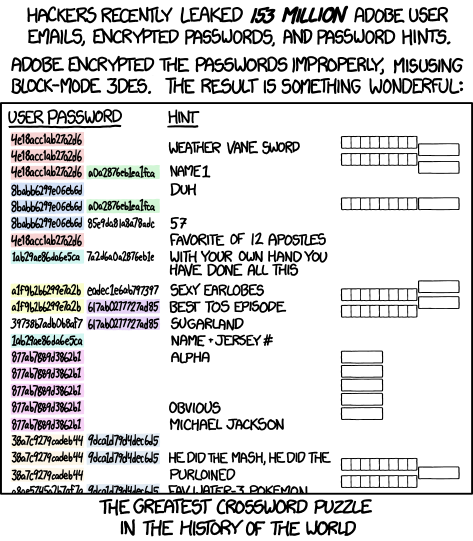
Encryptic by XKCD is licensed under a
Creative Commons Attribution-NonCommercial 2.5 LicenseXKCD Encryptic: crossword created from leaked Adobe passwords [below right]
- These Fonts Are Puzzles. Can You Solve Them?
mathematically inspired typefaces; NYT; 6/25/2021 - Helter Skelter
- Build your eye for wordplay with Joggle, the crossword (direct and cryptic) clueing game 4/7/2023
- Jumble
- kakuro: Cross-sums; kind of a combination of crossword and sudoku puzzles;
HSW: How Kakuro Puzzles Work; Quiz - NYT Op-Ed Puzzles
- Puzzle Mania! Will Shortz's Inside Look
podcast: 11:25; special 12/18/16 pp. section: 50x50 NYT crossword (728 clues);
Sudoku; Acrostics; Word games; Visual puzzles; NYT; 12/16/2016 - palindrome; The Palindromist Magazine; palindromelist.net; thinks.com
- 'Rise to Vote, Sir.' 'Now I Won!' World Palindrome Champion Crowned
(at ACPT); 3/27/2012 - Puzzazz site
-

QR code for this course:
communicrossings.com/crosswords
generated at:
wix.com/tools/qr-code-generator"qrosswords" name has occurred in a few different contexts:
- QR codes with their black & white squares resemble crosswords [on right, QR code for this site]
(though violate regular grid rules, e.g., symmetry, word length, connectedness) - cartoon: caption: "Those new-fangled crosswords. I just see them everywhere. They're so hard"
- Qrossword: A Financial Crossword that's also a QR code Citibank; 12/2011
- Making a QR code crossword 3/26/2014
- A Crossword Puzzle That Doubles As A QR Code 12/8/2011
- QRossword: crossword puzzle blank 5/25/2011
- QR-CODE CROSSWORD PUZZLE FROM THE THINGS WE KEEP
MoMA's Talk To Me exhibit provided the initial rationale for using the QR code as a basis
for this crossword puzzle. From MoMA's site: "Each object in the exhibition has its own
QR code, which allows visitors to bookmark it and access more information about
each object on the exhibition's website, in the galleries, or at home."; 2011 - Queer Qrosswords crosswords by LGBTQ+ constructors to benefit LGBTQ+ charities
- Psychometrically Activated Grids Acerbate Neuroticism Qrosswords and Daedalus Test; 2010
- Quiddler cross between Scrabble and the card game gin rummy; How Quiddler Works
- Regex Crossword clues are regular expression (Regex) patterns
- Can You Do The Regular Expression Crossword? from MIT Mystery Hunt; 2/12/2013
- New York Times Spelling Bee: 10 Tips and Strategies to Help You Win CNet; 2/17/2022
- Spelling Bee: Tips and Tricks NYT; 12/9/2021
- Str8ts logic-based number-placement puzzle
-

"Txtpert USA Today crossword puzzle"
by judy_breck
is licensed under CC BY-SA 2.0txtpert:
players decode numeric clues by referencing a telephone-style number pad.
For example, the number 2 could be the letters A, B or C (letters found on the number 2 key).
The clue for the word "CAT" would be the number 228 but those same numbers also spell out
the word "BAT" or "ACT" (seen in USA Today; texting skills handy). - Merriam-Webster promoted a word game littered with offensive terms
-- the latest reckoning over language in the puzzle world TypeShift; WaPo; 10/15/2021 - Upwords
- You Should Play: W.E.L.D.E.R. kind of a cross between Boggle and Tetris; iOS; 8/24/2012
- Word Adventure
Text Express; a crossword puzzle game "unlike any other"; 8/18/2022 - Finding a Shared Language Through Word Games
Solver Stories: Word Connect; NYT; 12/22/2021 - 'Word Hustle' A Game Of Competitive Crosswords Tabletop Game Review; 11/10/2020
- word ladder
- Crossword fans should give Apple Arcade's Wurdweb a try 8/13/2021
